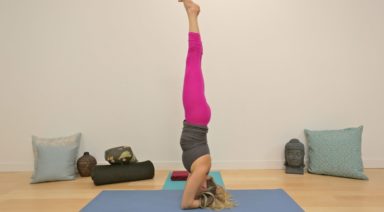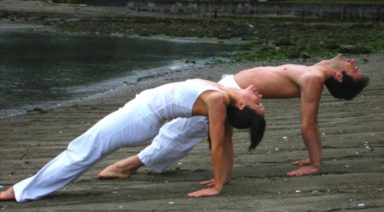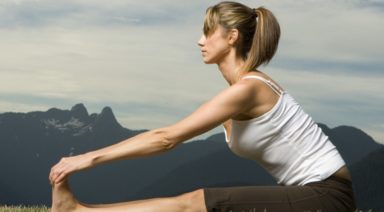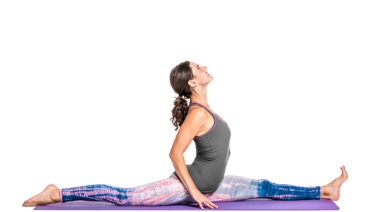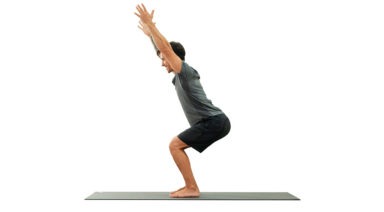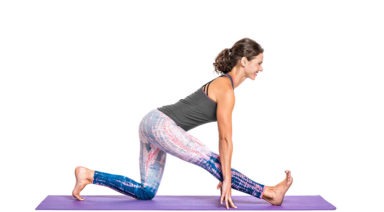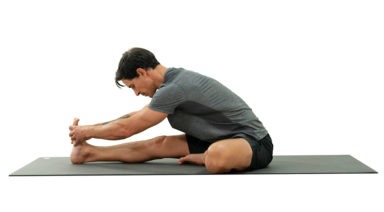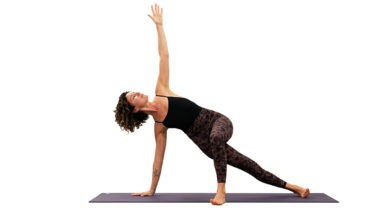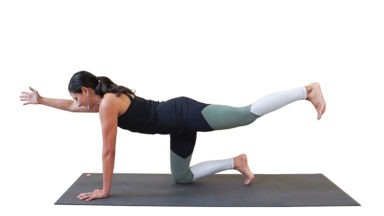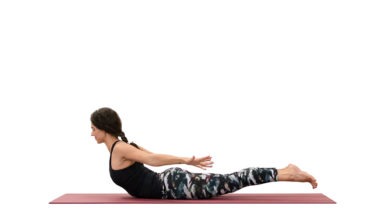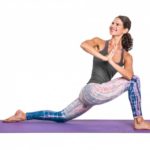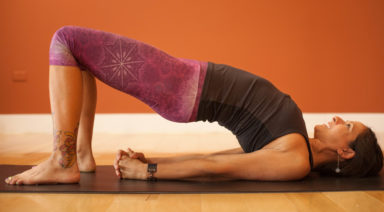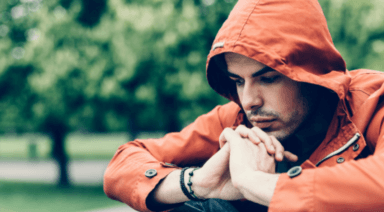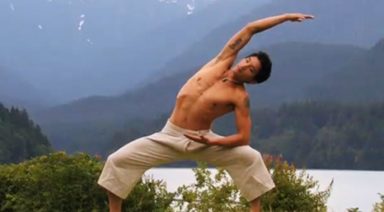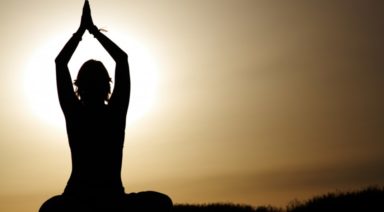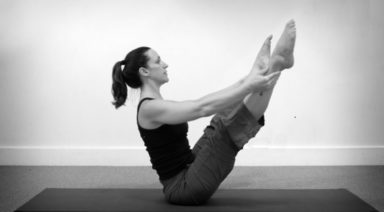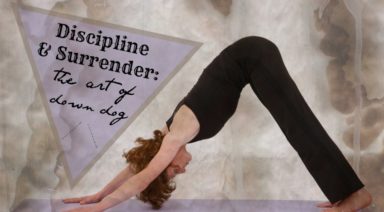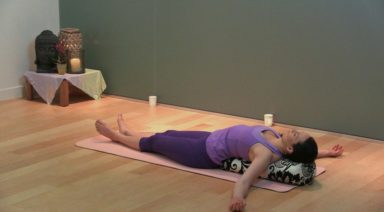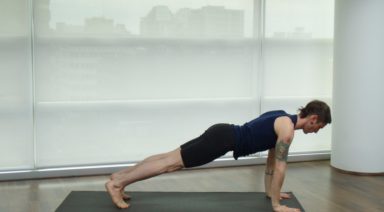Upper Arm Spirals in Down Dog
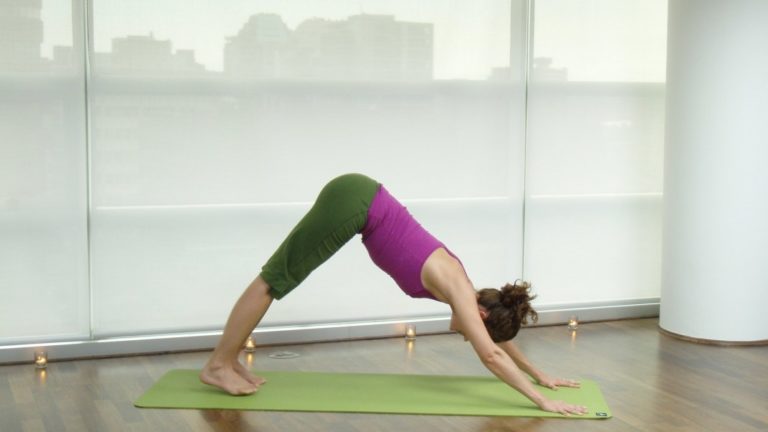
Downward Facing Dog pose (Adho Mukha Svanasana) comes across as basic forward bending Yoga pose – simple in its application and benefits. However, many yoga participants draw most of their attention to lower half of the body in achieving flexibility in the posterior lines (hamstring and calf muscles). The lack of attention on the placement and alignment of the upper body often dilutes the integrity and initial function of the pose.
Like all Yoga postures, Downward Facing Dog pose is meant to nourish the spine (and the energy channels traveling along with it) with a qualitative forward bend. In terms of being qualitative, this means the spine should enjoy renewed space, balance, and mobility. This includes all portions from the sacrum to the cervical spine (neck).
When one places all the emphasis on “pushing back” into the lower body’s rear line stretch, one tends to overuse the shoulder muscles (deltoids and supraspinatus). The unmindful contraction of these shoulder muscles draws the shoulder girdle (scapula bones) and the head of the humerus (upper arm bone) inwards towards the neck and ears.
The result of this inward motion of the shoulder girdle and arm bones is a crowding of the cervical vertebrae and the brachial nerve plexus. The brachial plexi are complex branches of nerves traveling from the neck and over the collar bone regions. This branch of nerves gives rise to virtually all the nerves that innervate the upper limbs.
This inwards crowding from the shoulder girdle also transmits a closing motion of the upper trapezius muscles (upper back) that often mirrors an unnecessary contraction of the trapezius and other extensor muscles along the back of the neck. This echoing contraction of these muscles causes the head to lift and move into a back arching motion – counter productive to the aim of being in a forward bend. The neck also does not take advantage of gravity and the natural elongation of the vertebrae that occurs went the head floats towards the ground.
Take note the next time you perform Downward Facing Dog pose. Are the shoulders pulling into the neck? If so, also notice the usage of your hands, the alignment of the head, and the relative situation of the shoulder blades to the ribs. With this awareness, you can then explore upper arm spirals to improve the quality of the posture.
Applying Upper Body Integrity:
An effective and subtle engagement of energy in the arms in the form of spirals can add significant space and mobility into the neck and upper spine. This space and integrity immediately transmits into more stability in the shoulder girdles and balanced loading of the shoulders and hands-together creating a more restful, qualitative Downward Facing Dog.
Spiral 1: Forearms
As you set up your pose, position your hands roughly the distance of the outer edge of the shoulders (people often have the hands inside the width of the shoulders adding to the crowding of the neck). Feel the fingers lightly spread, but not so much that you feel the tendons in the hands shortening vigorously. Line up the middle and index fingers forward so the hand is neutral with the wrist and forearm (and not turned inwards or excessively outwards). Then gently ground down through the index finger as though you are reaching out through that finger-tip. You will feel a slight pressure into the index finger pad as well as a subtle INWARDS rotation of the forearms. This is spiral 1. With this energetic spiral, you will draw compressive loading away from the outer wrist tissues and distribute the weight more evenly into the finger pads.
With this spiral, one MUST then apply spiral 2. Without spiral 2, the inwards rotation of the forearms, rotates the upper arm inwards as well adding even more crowding and compression into the neck and brachial plexi.
Spiral 2: Upper Arms
With the lower spirals set, visualize the shoulder blades hugging the ribs like suction cups and sliding up and away from the ears. A beautiful muscular connection occurs underneath and around the shoulder blades building strength and integrity for other poses. You will feel a very minute, but effective OUTWARDS rotation of the upper arms. Again, this is subtle. If it is overdone, this upper spiral will pull against the forearm spirals sending pressure into the outer wrists.
With this upper spiral, the trapezius muscles set over the shoulder and upper back spread like wings and the brachial plexus regions become more open. The echoing of the trapezius and extensor muscles dissipates allowing the head to release and flow away from the pelvis. The spine enjoys freedom and balance, and the pose shifts from a pushing ego to a therapeutic expansion.
A good learning tool for these spirals is to stand near a wall and to reach your arms up as high as you can on the wall. Like Downward Facing Dog, separate the hands and fingers. To demonstrate how Downward Facing Dog is often done incorrectly, slide the hands up as high as you can. Feel the tightness moving into the shoulders, trapezius muscles and neck.
Now, set your forearm spirals. Ground down and out through the index fingers. Notice the rotation of the forearms as well as the balance flowing into the surface area of the hands. From there, engage the muscles within the shoulder blades. Slide your shoulder blades down. Your hands will naturally slide down with the shoulder blades. Feel how easy it is to lengthen and open the tops of the shoulders and back with this shoulder girdle adjustment. Also, feel how subtle the upper arm naturally turns outwards. The advantage of this wall exercise is you can learn to do these spirals and feel the subtle changes without the loading forces of gravity on the shoulder and arms when in Downward Facing Dog.
The key word in these spirals is “natural”-not forced or exaggerated. A final sensation to become aware with these spirals is the reduction in shoulder muscle contraction combined with an additional use of the hip flexors. The shoulders must reduce their hold to allow for the spirals to occur, therefore the hip flexors (iliopsoas and rectus fermoris) compensate and engage. This engagement of the hip flexor muscles improves the forward bending motion at the hips, generates a more effective lift of the sit bones (ischial tuberosities), and creates a more effective expansion of the hamstrings.
In summary, play with the spirals together in your Downward Facing Dog pose. One spiral must be accompanied by the other. Maintain a holistic approach keeping the spine your first priority. Let this holistic intention then flow out through the pelvis and shoulders ending with the limbs. Click here to read more about spirals for the wrist and other ways to protect the wrist joint in Downward Facing Dog pose.
Explore the Anatomy and Correct Alignment of Headstand Pose

Knowledge dissolves fear. With a basic understanding of the structures in your neck, and application of these five keys, one can practice sirsasana safely.
Let’s first take a look at the anatomy, and the neck’s role in our daily life.
The seven little bones of the cervical spine (neck bones) are unique in that they are designed for mobility rather than stability. Like other joints in the body, where stability is sacrificed for mobility, the primary purpose of the C spine in daily life is ease of movement. Therefore, ideal alignment and muscular harmony are particularly important.
The load bearing structures of a cervical vertebrae are the body and two articular facets. A typical cervical vertebral body is approximately two centimeters in diameter depending on the vertebrae (C3 – C7), gender, and individual differences. This is comparable to the diameter of a dime. One may make the comparison of a lumbar vertebral body and cervical vertebral body to the chunky heel of a walking shoe to a high heeled pump. Imagine walking a gravel road in stilettos versus the former.
Another feature worth noting is that the C spine houses the vertebral arteries. Transverse foramen, or holes from top to bottom on the side wings of the bones, house this paired blood vessel which travels up to the brain, taking a rather alarming posterior jog at the top of the neck bones before entering the skull. Symptoms of blocking this small artery include dizziness, blurred vision and occipital headaches. Any lesion compromising the integrity of this passage way is exacerbated by misalignment and the additional and uncustomary weight of your body on the cervical vertebrae in a posture like sirsasana.
Nerves exit the intervertebral foramen (holes in the sides between the neck bones), the branches of which pass laterally between the anterior and middle scalene muscles. These muscles help to hold your head and neck up like guide wires, and provide movement in your neck. Overuse these muscles through misalignment or overload them, and they will become inflamed or tight, possibly pinching the nerves.
How to Safely Practice Headstand (Sirsasana)
Armed with this information, how can you incorporate sirsasana safely into your practice? Headstand or any posture for that matter doesn’t have to look like the pose in your yoga syllabus to start. Practice the actions of the pose in a modification, and you will receive more benefit than forcing the pose.
Here are some important points to practice sirsasana.
1. A strong headstand begins with sensible upright posture.
Carry your upper palate above your physical heart. Assume a natural lordosis in your neck. Your best posture will be your tallest, most easeful posture. Maintain this easeful alignment of your spine in upright yoga postures. If you don’t know what good alignment feels like upright, you won’t know what it feels like upside down.
Practice holding Tadasana in ideal alignment and full attention for several minutes. To simulate the postural muscles further, root down from the outer hips into your feet. Place a block on top of your head while standing, and root up into it from your upper palate as you gently resist. Breathe fully to expand and lengthen your torso. Drop your shoulders away from your ears, and slide the upper arms back to widen the clavicles (collar bones). Invite the ribs back, as this action tends to cause them to splay forward. Breathe into your back, particularly just above the waist.
Practice integrating your body from head to feet with these polar actions of rooting and lifting. When you are in perfect alignment, your body will feel like your favorite pair of walking shoes: No friction, no effort, just ease.
Which brings me to the next key.
2. Stretch your hamstrings and plantar fascia.
To get into any posture, the closer to ideal postural alignment you can get, the less likelihood of injury. To keep your neck safe in headstand, you need to be able to align your entire spine before taking away the support of your feet. In order to achieve this, the back of your legs and soles of your feet must be supple enough to walk into the posture without rounding the lower back and therefore the neck.
3. Apply the rules of progressive overload.
No one walks into a gym and does a clean and jerk with 150 pounds off the bat with no experience. So why would headstand be any different? The neck is accustomed to bearing a mere ten pounds of weight. Add resistance incrementally in weight and duration.
4. Create a stable foundation.
** **When you are ready to do sirsasana, interlace your fingers into prayer hands, with the exception of your pinky fingers. Your pinky fingers should be stacked, overlapping each other front to back. You should be able to see both middle fingers from above but not any of your palm to start–so slightly pronate your forearms. Once you tuck your head into your palms, the tendency is to roll onto the dorsum (back) of your hand. Starting in slight pronation will bring you into neutral alignment once you are in the posture. Now root down through parallel upper arms into the forearms, wrists and hands while keeping the spine neutral and your chest open. Nestle the back of your head into your hands. Distribute the weight between the crown of your head, forearms, wrists and hands.
5. Keep your mouth shut.
This one is mostly for teachers. Although designed primarily to aid in tongue movement and swallowing, the variety of muscles attached to the base of the tongue help to support your neck. Anchor the tongue to the roof of your mouth for additional stability. When it comes to standing on your head, recruit as much help as possible. So teachers, explain your demo first, and don’t speak once you are in the posture.
Precautions and Contraindications
There are precautions and contraindications to performing sirsasana, such as osteoarthritis of the C spine, any autoimmune disease affecting the musculoskeletal system, diabetes, heart condition, degenerated discs, down syndrome, or any other pathology affecting the neck.
However, even with these conditions, one can enjoy many of the benefits of the pose by simply embodying the actions of the pose in a modified form. With patience and keen attention, headstand can be performed safely to benefit your wellbeing.
Naomi Friesen possesses a deep understanding of the physical body through 20 years of teaching movement and anatomy. Students benefit from her knowledge of sound biomechanics by receiving safe and effective instruction. A personal trainer, pilates instructor and lifestyle/weight management coach for 12 years, she now teaches yoga after receiving her yoga instructor certification through Open Source Yoga School. Naomi’s intention is to facilitate connection for herself and students through yoga – connection to Source, connection between the parts of our body, our connection to others.
Website: www.victoriaschoolofyoga.com
Facebook: Victoria School of Yoga


